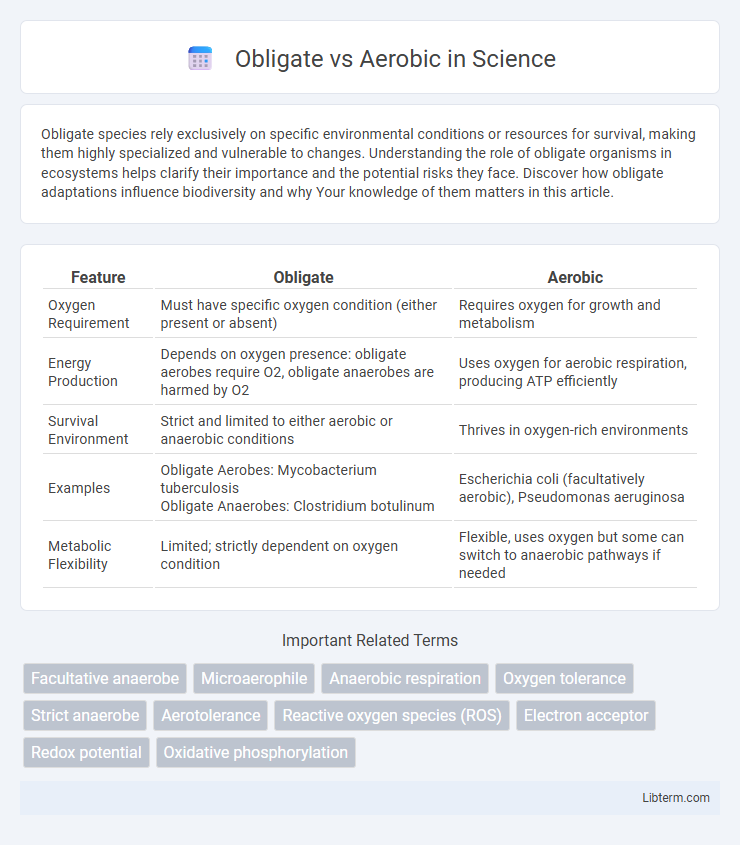Obligate species rely exclusively on specific environmental conditions or resources for survival, making them highly specialized and vulnerable to changes. Understanding the role of obligate organisms in ecosystems helps clarify their importance and the potential risks they face. Discover how obligate adaptations influence biodiversity and why Your knowledge of them matters in this article.
Table of Comparison
| Feature | Obligate | Aerobic |
|---|---|---|
| Oxygen Requirement | Must have specific oxygen condition (either present or absent) | Requires oxygen for growth and metabolism |
| Energy Production | Depends on oxygen presence: obligate aerobes require O2, obligate anaerobes are harmed by O2 | Uses oxygen for aerobic respiration, producing ATP efficiently |
| Survival Environment | Strict and limited to either aerobic or anaerobic conditions | Thrives in oxygen-rich environments |
| Examples | Obligate Aerobes: Mycobacterium tuberculosis Obligate Anaerobes: Clostridium botulinum |
Escherichia coli (facultatively aerobic), Pseudomonas aeruginosa |
| Metabolic Flexibility | Limited; strictly dependent on oxygen condition | Flexible, uses oxygen but some can switch to anaerobic pathways if needed |
Introduction to Microbial Oxygen Requirements
Obligate aerobes require oxygen for survival, relying on it as the final electron acceptor in aerobic respiration, while obligate anaerobes are harmed or killed by oxygen due to the absence of protective enzymes like catalase or superoxide dismutase. Facultative anaerobes can grow with or without oxygen by switching between aerobic respiration and fermentation, whereas microaerophiles need low oxygen concentrations for optimal growth. Understanding these microbial oxygen requirements is crucial for optimizing culture conditions and controlling microbial growth in medical, environmental, and industrial applications.
Definition of Obligate Organisms
Obligate organisms are species that require specific environmental conditions for survival, such as obligate aerobes needing oxygen to grow and produce energy through aerobic respiration. These organisms cannot survive without the presence of oxygen, distinguishing them from facultative or obligate anaerobes that thrive in oxygen-free environments. Obligate aerobes include bacteria like Mycobacterium tuberculosis, which rely exclusively on aerobic metabolic pathways for energy.
Definition of Aerobic Organisms
Aerobic organisms are defined by their requirement for oxygen to survive and generate energy through cellular respiration. These organisms utilize oxygen as the final electron acceptor in the electron transport chain, maximizing ATP production efficiently. Obligate aerobes, a subset of aerobic organisms, cannot thrive without oxygen due to their reliance on aerobic metabolic pathways.
Key Differences: Obligate vs. Aerobic
Obligate organisms require a specific environmental condition to survive, such as obligate aerobes that strictly depend on oxygen for cellular respiration, while obligate anaerobes are harmed by oxygen and rely on alternative metabolic pathways. Aerobic organisms encompass both obligate aerobes and facultative aerobes, the latter capable of switching between oxygen-dependent and anaerobic metabolism based on oxygen availability. The key difference lies in the strict oxygen requirement of obligate aerobes, contrasting with facultative aerobes' metabolic flexibility and obligate anaerobes' oxygen intolerance.
Metabolic Pathways Involved
Obligate aerobes rely exclusively on aerobic respiration, utilizing oxygen as the final electron acceptor in the electron transport chain to generate ATP efficiently through oxidative phosphorylation. In contrast, obligate anaerobes lack components of the aerobic respiratory chain and instead depend on anaerobic metabolic pathways such as fermentation or anaerobic respiration, using alternative electron acceptors like nitrate or sulfate. The key metabolic difference lies in the presence or absence of cytochrome oxidase and other enzymes of the electron transport chain that facilitate oxygen-dependent ATP synthesis.
Environmental Niches and Adaptations
Obligate aerobes require oxygen for survival and are adapted to environments rich in oxygen, such as surface soils and water exposed to air. Obligate anaerobes thrive in oxygen-deprived habitats like deep sediments or the gastrointestinal tract, where they rely on alternative electron acceptors for metabolism. These distinct environmental niches drive evolutionary adaptations in microbial respiratory enzymes and metabolic pathways, optimizing energy production under specific oxygen conditions.
Examples of Obligate and Aerobic Microbes
Obligate anaerobes such as Clostridium botulinum and Bacteroides fragilis cannot survive in the presence of oxygen, thriving only in oxygen-free environments. In contrast, obligate aerobes like Mycobacterium tuberculosis and Pseudomonas aeruginosa require oxygen for growth and energy production through aerobic respiration. These distinctions in oxygen requirements highlight the adaptation of microbes to their specific ecological niches and metabolic pathways.
Impact on Human Health
Obligate aerobes require oxygen for survival, playing a crucial role in maintaining human health by supporting beneficial microbiota and aiding in immune system function. In contrast, obligate anaerobes thrive in oxygen-free environments and include both harmless gut flora essential for digestion and pathogenic bacteria responsible for infections like tetanus and botulism. Understanding the balance between obligate aerobic and anaerobic bacteria is vital for developing targeted treatments and managing conditions such as inflammatory bowel disease and respiratory infections.
Laboratory Identification Techniques
Laboratory identification of obligate versus aerobic bacteria relies on culturing methods in controlled oxygen environments where obligate anaerobes fail to grow in the presence of oxygen, while obligate aerobes require oxygen for growth, observable on media like thioglycollate broth or agar plates in aerobic incubators. Techniques such as the use of anaerobic jars or chambers create an oxygen-free atmosphere essential for isolating obligate anaerobes, whereas obligate aerobes thrive in standard aerobic incubators at 37degC. Microscopic examination combined with biochemical tests, including catalase and oxidase assays, further differentiates obligate aerobes based on their ability to metabolize oxygen.
Importance in Biotechnology and Industry
Obligate aerobes require oxygen for cellular respiration, making them essential in aerobic fermentation processes used in biotechnology to produce antibiotics, enzymes, and biofuels. Their ability to efficiently generate energy in the presence of oxygen is exploited in industrial bioreactors to enhance yield and reduce production time. Understanding the metabolic needs of obligate aerobes versus facultative anaerobes helps optimize microbial growth conditions, improving scalability and cost-effectiveness in large-scale bioprocesses.
Obligate Infographic

 libterm.com
libterm.com